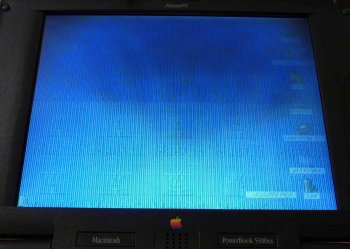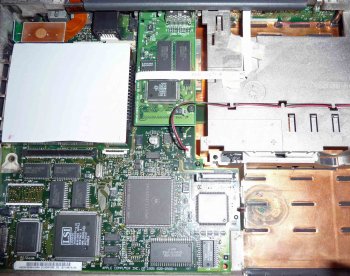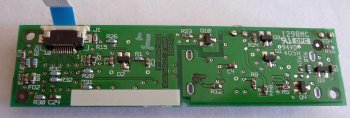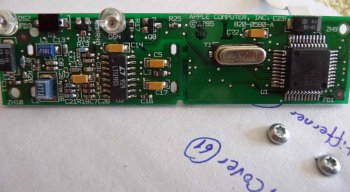I recently picked up a PowerBook 5300cs, and (given their sad reputation) before some irreverent wag asks if it was from a trash can - it wasn't. I paid around $10 for this piece of interesting Apple vintage.
- it wasn't. I paid around $10 for this piece of interesting Apple vintage.
There's a fair bit of literature around about some of Apples 'failures', which makes for fascinating reading, and which I guess in my case, added to the intrigue. (I even have a boxed, near-mint example of the QuickTake 100) for similar related reasons.
The summary given by LowEndMac also makes interesting reading. So far, with the exception of the internal mouse tongue, I've seen very few 5300 'dropping's.
So not surprisingly, I set myself the task of finding a 'decent 5300' - which may be an oxymoron in itself!
A few pics follow:
![5300cs.jpg 5300cs.jpg]()
![5300cs_2.jpg 5300cs_2.jpg]()
I'd been told verbally by the seller, that the exterior condition was very good (that to me was a high priority), that it was functional, always booted to OS, (although occasionally to a poor pixelated resolution screen), so obviously needed some care & attention - often a challenge I find hard to resist. So this PowerBook sounded like it met my criteria.
In the car park where the 10€ and the PowerBook changed hands, during start-up trials, each time it booted correctly to a clear screen, so there was clearly still some life left in the old girl.
Back home, I immediately attacked her with a #9Torx, and found that the probably original main battery had been left in, with some slight leakage, leading to fortunately only superficial oxydation just to the internal connection. This was easily cleaned off. The PRAM battery - no doubt long expired - fortunately was adequately protected and showed no signs of leakage (next photo).....
![5300cs_3.jpg 5300cs_3.jpg]()
One issue that will keep me occupied in finding a solution, is the mouse mechanism. It was barely functional, the reason for which was obvious. The plastic 'tongue' had fractured as shown here......
![5300cs_4.jpg 5300cs_4.jpg]()
I'll attempt an epoxy repair, but even if successful will only be temporary, until I can replace that complete sub-assembly. Shown below:
![5300cs_5.jpg 5300cs_5.jpg]()
No doubt I'll find a few more issues along the way, which I guess is all part of the fun.
I'd be very interested to hear if anyone can suggest another PowerBook of similar vintage which shares common parts - especially the mouse mechanism. If so this may make it easier to source spares.
And harking back to oxymorons, and a report by a certain Riccardo Mori 'In defence of the Powerbook 5300, I guess one could say that this was an 'awfully good' Powerbook in it's day. And in the same vein, I find I have a 'cool passion' for this PowerBook; in fact I'm quite 'cheerfully pessimistic' about my find!
There's a fair bit of literature around about some of Apples 'failures', which makes for fascinating reading, and which I guess in my case, added to the intrigue. (I even have a boxed, near-mint example of the QuickTake 100) for similar related reasons.
The summary given by LowEndMac also makes interesting reading. So far, with the exception of the internal mouse tongue, I've seen very few 5300 'dropping's.
So not surprisingly, I set myself the task of finding a 'decent 5300' - which may be an oxymoron in itself!
A few pics follow:
I'd been told verbally by the seller, that the exterior condition was very good (that to me was a high priority), that it was functional, always booted to OS, (although occasionally to a poor pixelated resolution screen), so obviously needed some care & attention - often a challenge I find hard to resist. So this PowerBook sounded like it met my criteria.
In the car park where the 10€ and the PowerBook changed hands, during start-up trials, each time it booted correctly to a clear screen, so there was clearly still some life left in the old girl.
Back home, I immediately attacked her with a #9Torx, and found that the probably original main battery had been left in, with some slight leakage, leading to fortunately only superficial oxydation just to the internal connection. This was easily cleaned off. The PRAM battery - no doubt long expired - fortunately was adequately protected and showed no signs of leakage (next photo).....
One issue that will keep me occupied in finding a solution, is the mouse mechanism. It was barely functional, the reason for which was obvious. The plastic 'tongue' had fractured as shown here......
I'll attempt an epoxy repair, but even if successful will only be temporary, until I can replace that complete sub-assembly. Shown below:
No doubt I'll find a few more issues along the way, which I guess is all part of the fun.
I'd be very interested to hear if anyone can suggest another PowerBook of similar vintage which shares common parts - especially the mouse mechanism. If so this may make it easier to source spares.
And harking back to oxymorons, and a report by a certain Riccardo Mori 'In defence of the Powerbook 5300, I guess one could say that this was an 'awfully good' Powerbook in it's day. And in the same vein, I find I have a 'cool passion' for this PowerBook; in fact I'm quite 'cheerfully pessimistic' about my find!
Last edited:







